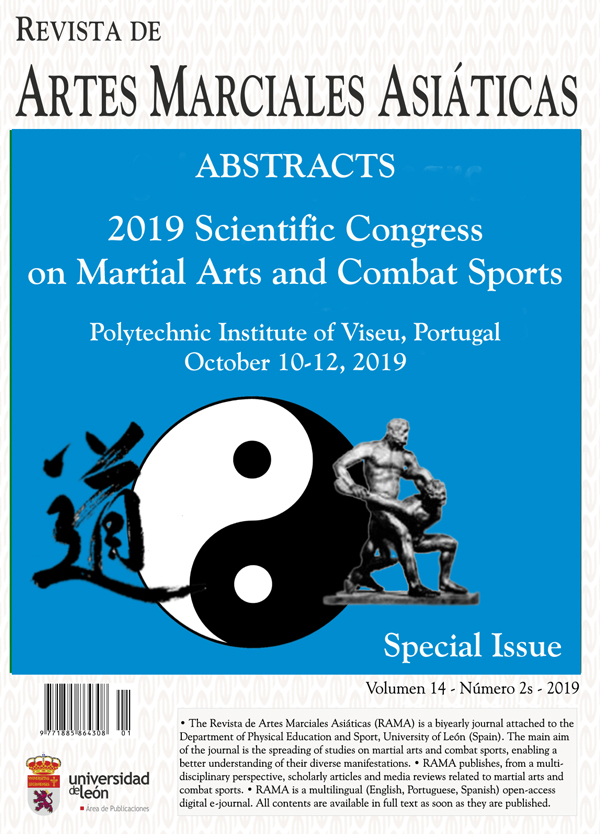Old Polish warrior's path - psychophysical and martial preparation of a young nobleman in modern Poland
DOI:
https://doi.org/10.18002/rama.v14i2s.5965Palavras-chave:
Martial arts, Polish martial arts, Polish sabre fencing, palcaty, training methodology, short stick fightingEntidades:
Idokan Poland Association in Rzeszów (Poland)Resumo
The article attempts to outline the path a young nobleman underwent in the 16-17th century Poland in order to achieve prowess in battle martial arts. It presents patterns and ways of training the nobleman was subjected to from an early age, the process of a future warrior’s mental and physical preparation. Furthermore, it describes various types of body exercises and trainings with many weapon types. A fundamental novelty is presentation of the training methodology. Its over four centuries of age notwithstanding it has basically been valid until nowadays and encompasses such features as diet or exercise intensity. Eventually this article presents the individual stages of said training, closely related to warrior’s age and psychophysical development. Material for the study was obtained thanks to the textual analysis, both from the era (16 to 17th century sources) and from the limited literature on the topics (monographs, magazine articles, periodicals, the Internet) addressing the subject. The result depicts arduous, however consistent and sensible old Polish training system. After many years of wisely carried out exercises an effective, skilled warrior was produced, furnished with high fighting skills and morale, ready to fight his country enemies. At the same time whilst getting old such a warrior could train the next generations of Homeland’s knights-defenders. The objective of the article is to draw attention to the subject of Polish warriors, their training and martial arts, hitherto unmentioned in English literature and to encourage further research in this field.
Downloads
Métricas alternativas
Referências
Borysiuk, Z. (2005). Historyczne przeobrażenie szabli jako broni siecznej. Ido – Ruch dla Kultury / Movement for Culture, 5, 9-15.
Brzeziński, R. (1987). The Polish Armies 1569-1696 (vol 1). London: Bloomsury Publishing.
Cynarski, W. J. (2012). A Christian and the martial arts path. Ido Movement for Culture. Journal of Martial Arts Anthropology, 16(2), 1-7. doi: http://doi.org/10.14589/ido.16.2.1
Cynarski, W. J. (2019). Martial Arts & Combat Sports: Towards the General Theory of Fighting Arts. Gdańsk: Wydawnictwo Naukowe Katedra.
Cynarski, W. J., & Litwiniuk, A. (2000). Metody przygotowani psychicznego w sztukach walki. Ido-Ruch dla Kultury / Movement for Culture, 1, 121-124.
Czajkowski, Z. (2007). Szermierka w dawnej Polsce. Ido – Ruch dla Kultury / Movement for Culture, 7, 55-64.
Górnicki, Ł. (1566). Dworzanin polski. Warszawa: Maciej Wirzbięta.
Łaski, S. (1599). Spraw i postępków rycerskich i przewagi opisanie krótkie. Lwów: M. Bernat.
Maroteaux, R. J. (2011). Special sabre polonais & japonais. Aiki Goshin Do Kaishi, (55), 12-22. Avignon.
Maroteaux, R. J. (2019). Special sabre polonais. Aiki Goshin Do Kaishi, (77), 23-27.
Marsden, R. (2015). The polish saber. Cambridge: Tyrant Industries.
Paprocki, B. (1584). Herby rycerstwa polskiego. Kraków: Maciej Garwolczyk.
Petrycy, S. (1605). Polityki Arystelesowej to jest rządu rzeczypospolitej z dokładem ksiąg ośmioro, część wtóra. Kraków: S. Kempini.
Pokojski, K. (2019). Sarmaci najczystszym narodem chrześcijańskiej Europy – brud w XVI-XVII wiecznej Europie. Retrieved from http://www.kresy.pl/kresopedia,historia,rzeczpospolita?zobacz%2Fsarmaci-najczystszym-narodem-chrzescijanskiej-europy-brud-w-xvi-xvii-wiecznej-europie
Pokojski, K. (2019). Szkolenie rycerskie jako istotny element wychowania młodego szlachcica w XVI-XVIII wieku. Retrieved from http://szablaipiorem.pl/szkolenie-rycerskie-jako-istotny-element-wychowania-modego-szlachcica-w-xvi-xvii-wieku
Pokojski, K. (2015). Tczew 1627. Warszawa: Erica.
Rej, M. (1567). Zwyerciadło albo kstałt w którym każdy stan snadnie się może swym sprawom iako we źwierciadle przypatrzyć. Kraków: M. Wirzbięta.
Sawicki, Z. (2014). Influence of the Polish martial art onto European armies in the 18th and 19th centuries. Ido Movement for Culture. Journal of Martial Arts Anthtopology, 14(4), 3-13. doi: https://doi.org/10.14589/ido.14.4.2
Sawicki, Z. (2008). Michała Starzewskiego traktat „O szermierstwie” w interpretacji Zbigniewa Sawickiego. Zawiercie: Wydawnictwo Signum Polonicum.
Sawicki, Z. (2005). Palcaty. Podręcznik dla początkujących. Zawiercie: Wydawnictwo Signum Polonicum.
Sawicki, Z. (2019). Palcaty Staropolska szermierka na kije (Studium historyczne z dziejów kultury fizycznej). Author’s collection materials from doctoral dissertation.
Sawicki, Z. (2011). PolishMartialArts – Signum Polonicum: Historical background and the main plots of the system. Ido Movement for Culture. Journal of Martial Arts Anthtopology, 11(2), 38-46.
Sawicki, Z. (2012). Traktat szermierczy o sztuce walki polską szablą husarską część druga. Zawiercie: Wydawnictwo Napoleon V.
Sawicki, Z. (2004). Traktat szermierczy o sztuce walki szabla husarską. Podstawy. Zawiercie: Wydawnictwo Signum Polonicum.
Starowolski, Sz. (1631). Sarmatiae Bellatores, Koln: H. Kritius.
Testament Stanisława Żółkiewskiego. (1606). In A. Krasiński (Ed.). (1845). Biblioteka warszawska (Vol. 2, pp. 303-311). Warszawa: W Drunkarni Stanislawa Strabskiege.
Downloads
Publicado
Como Citar
Edição
Secção
Licença
Direitos de Autor (c) 2019 Jakub Pokojski

Este trabalho encontra-se publicado com a Licença Internacional Creative Commons Atribuição-NãoComercial-CompartilhaIgual 4.0.
Os autores que publicam nesta Revista estão de acordo com os seguintes termos:
- Os autores cedem, de forma exclusiva, os direitos de exploração (reprodução, distribuição, comunicação pública, transformação) à Universidade de Léon, podendo estabelecer, em separado, acordos adicionais para a distribuição não exclusiva da versão do artigo publicado na Revista (por exemplo: alojar no repertório institucional ou publicá-lo num livro), com o reconhecimento da publicação inicial nesta Revista.
- O trabalho encontra-se na Creative Commons Attribution-Non Commercial-Share Alike 4.0 International License. Pode-se consultar aqui o resumo e o texto legal da licença.
- Permite-se, e sugere-se, que os autores difundam electronicamente as versões pré-impressão (versão antes de ser avaliada) e pós-impressão (versão avaliada e aceite para publicação das suas obras antes da sua publicação), favorecendo a sua circulação e difusão, e com ela o possível aumento da sua citação e alcance pela comunidade académica.











